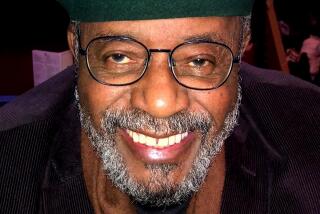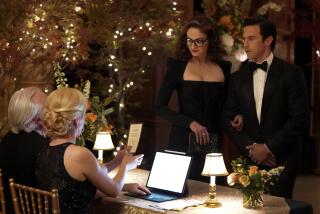‘Blue Bloods’: Tom Selleck and the cop family drama rule Fridays
NEW YORK — On a soundstage in an industrial Brooklyn neighborhood, Tom Selleck sits at the head of a prop-heavy dinner table filled with three generations of actors.
As a crew goes about its preparations, there’s little wisdom that Selleck won’t dispense: his March Madness pick (Duke, because “Coach K is a great guy, and his players graduate”), his aversion to gourmet vegetables, his favorite lines from “Airplane.”
Then the cameras roll, and he’s doling out nuggets all over again.
“It takes guts to stand by your principles, not just when it’s easy but it costs you something,” he offers sagely, this time in character as police commissioner Frank Reagan.
Welcome to CBS’ “Blue Bloods.” Now in its unexpectedly successful third season, the show not only has marked the “Magnum, P.I.” star’s triumphant return to series TV (“he’s the patriarch of the cast the way he’s the patriarch on the series,” said costar Will Estes) but may very well be the most popular television show no one talks about.
Despite airing in prime-time’s semi-wasteland of Friday night, “Blue Bloods” is now watched by nearly 13 million people, making it one of the most popular programs on network television (even if, with a median age of 62, it also has the oldest audience of any show on the broadcast airwaves). In a climate where network hourlongs tend to be either grisly crime thrillers (“Criminal Minds”) or soapy mysteries (“Scandal”), “Blue Bloods” is an anomaly: a family drama that just happens to wear procedural clothing.
“It’s easy to put it out of mind because it’s on a Friday night,” said Kelly Kahl, senior executive vice president of prime time for CBS. “But the numbers are extraordinary. There’s a family element that separates it from a typical cop show.”
If you’re not familiar with it, “Blue Bloods” centers on the crisscrossing plots — sometimes procedural, sometimes familial — of New York’s law-enforcement Reagan family. There’s police commissioner Frank (Selleck), son and detective Danny (Donnie Wahlberg), daughter and prosecutor Erin (Bridget Moynahan), son and beat cop Jamie (Will Estes) and Frank’s father (Len Cariou, in real life just a few years older than Selleck), daughter-in-law and assorted grandchildren.
For one shooting day each episode, Selleck & Co. gather for the scene they call “family dinner,” hashing out professional and personal issues, all in the presence of their wisdom-dishing, frequently sighing paterfamilias. (On this day, as they butter rolls and crunch spinach leaves, Danny Reagan and his wife are tensely discussing an ethical dilemma that’s put them at cross-purposes, Danny’s son is nervous about a boxcar derby, and Erin is battling her own conscience.)
The dinner scene is a fixture of the series, made at the insistence of executive producer Leonard Goldberg when he pitched it to Les Moonves more than three years ago. Its existence is highly symbolic. Though one can’t get around that this is a CBS crime show with an open-and-shut case in every episode — something the network insisted on, Goldberg said — those who work on “Blue Bloods” take pride in the family dinner and believe it’s the type of scene that drives the program’s success.
“No one ever comes up to me and says, ‘I loved the way you got the bad guy.’ It’s ‘I loved that conversation you had with your granddaughter on the stoop,’” said Selleck, who in person can come off as an odd mix of self-deprecating and not lacking for confidence. (It’s clear that the actor has no desire to be on a pure procedural; he says with some pride that when he worried the show was moving that way, CBS Entertainment President Nina Tassler told him, “We don’t use the ‘P’ word around your show.”)
Birthed in part by the veteran Hollywood producer and executive Goldberg, who with Aaron Spelling was responsible for series such as “Charlie’s Angels” and “Hart to Hart,” “Blue Bloods” faced hurdles from the start. CBS made it the last greenlight of the fall 2010 season, then slotted it in the backwater of Friday night.
While numbers that first year were solid, there was tension between co-creators and show runners Robin Green and Mitchell Burgess and, among other personalities, Selleck, who didn’t like some of the procedural direction. The duo was removed as show runners after the first season and replaced by Ed Zuckerman, a “Law & Order” veteran.
But Zuckerman struggled a little too — “He never really got the hang of the family stuff,” Goldberg said — and for this season he’s been replaced by Kevin Wade, a longtime screenwriter of slice-of-life comedies such as “Working Girl” and “Maid in Manhattan.”
The fix appears to have worked. Numbers are higher than they’ve ever been for the series — it averages 12.9 million viewers, up 5% from last season. The show seems to be hitting its creative stride too. Family dynamics are moving in new directions — Danny’s wife, for instance, has been given a job, creating marital tension between them.
“We want to do the reverse of what a lot of procedurals do,” Wade said. “We don’t write the complicated mystery for the big guest character. We turn the lens in the opposite direction — to make sure the crime story holds a mirror up to the [main] character.”
“Blue Bloods” may also benefit from its oddly throwback structure. While many of the hits have put a clever spin on the contemporary domestic life, this one avoids most of the tricks to focus on a nuclear unit.
“It’s the family you don’t see on TV anymore,” Wahlberg said from his dressing room after he finished shooting the dinner scene. “Everybody’s so busy trying to create the most outlandish family on TV, they forgot about the traditional family.”
And then there’s Selleck, who for nearly half the year uproots himself from his avocado ranch in Freedom, Calif., to work in a scruffy part of Brooklyn. The actor — yes, a makeup person does brush his mustache between takes — is known for being seen about town, where he has a particular appeal to older women; Goldberg likes to say that some will come up to him and disbelievingly exclaim “You’re him,” to which he might quip back, “I used to be.”
The actor is clearly happy to be back on series television, saying that after his recurring role on “Friends” more than a decade ago he was frustrated that he couldn’t get a new series off the ground. (He did star as the detective Jesse Stone in a number of CBS TV movies, the last one airing in May.)
Still, it’s hard to ignore that, if Selleck is key to his show’s success, he’s also, at 68 and known well by an older generation that watched “Magnum, P.I.,” part of why it skews older. (Kahl said the network would like to lower the median age somewhat — plotlines involving Estes and the grandchildren could help — but that there are built-in obstacles on Friday night.)
In many ways, “Blue Bloods” is a program that embodies the tricky balances at a network like CBS, where an older star can drive viewership, and where character elements are pushed, frequently if tentatively, against procedural limits.
“I don’t think we’re reinventing the wheel,” said Selleck. “But I don’t think you can confuse us with other shows on the air, either. We’re putting our own wrinkle on things.”
PHOTOS, VIDEOS & MORE:
PHOTOS: Behind the scenes of ‘Downton Abbey’
VIDEO: Winter TV preview
PHOTOS: Violence in TV shows
More to Read
The complete guide to home viewing
Get Screen Gab for everything about the TV shows and streaming movies everyone’s talking about.
You may occasionally receive promotional content from the Los Angeles Times.







